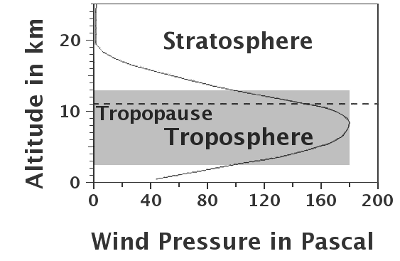|
Size: 3977
Comment:
|
Size: 3977
Comment:
|
| Deletions are marked like this. | Additions are marked like this. |
| Line 12: | Line 12: |
| || {{ attachment:windP3.png }} || This is the wind pressure on the hanging cables. Instead of a round cylinder, assume an aerodynamic, streamlined cross section that steers into the wind, 10 cm crosswind with a drag coefficient of 0.2 (assuming some flutter). So the drag force per meter at the peak wind is less than 2 newtons per meter ( 0.5 * 0.2 * 0.1 m * 180 N/m^2^ ); though 10 km of atmosphere that is 20 kN. If we assume that force is applied at 10 km altitude, it displaces the aerostat cable at an angle of 20/1200 radians (about 10°) for a horizontal displacement of 10,000/60 or 170 meters. Not much for high winds at altitude. || | || {{ attachment:windP3.png }} || This is the wind pressure on the hanging cables. Instead of a round cylinder, assume an aerodynamic, streamlined cross section that steers into the wind, 10 cm crosswind with a drag coefficient of 0.2 (assuming some flutter). So the drag force per meter at the peak wind is less than 2 newtons per meter ( 0.5 * 0.2 * 0.1 m * 180 N/m^2^ ); though 11 km of atmosphere that is 20 kN. If we assume that force is applied at 10 km altitude, it displaces the aerostat cable at an angle of 20/1200 radians (about 10°) for a horizontal displacement of 10,000/60 or 170 meters. Not much for high winds at altitude. || |
Aerostat 183 GHz Rectenna for SSPS
Space solar power satellites beaming 2.45 GHz or 5.8 GHz microwaves to earth require huge antennas and create enormous interference for communications, radar, and space science. We can make both transmit and receive antennas much smaller and cheaper, and eliminate interference to the earth, if we instead use 183 GHz ( λ = 1.64 mm ) and a 2 kilometer diameter aerostat rectenna at 20 kilometers altitude, feeding huge power cables to the ground.
Assume a rectenna at 60°N latitude, L = 40,000 km from the rectenna. The first Airy null is 1.22 λ × L / RT kilometers from boresight where RT is the radius of the transmitter. If we make the rectenna radius RR a bit more than twice that, we will capture almost all of the transmitted energy, thus RT × RR = 2.5 λ × L = 410000 m2 . If RT = 410 meters, then RR = 1000 meters.
Assume an average receive power density of 1 kW/m2 (much higher at the center), for a total power of 3.2 GW. Assume that will be sent to the ground as differential 500 kV at 32 kA total.
Assume the aerostat platform is 100 meters high and filled with hydrogen. Since air density is 7% of the 1.225 kg/m3 at the surface, this platform displaces 0.086 kilograms per cubic meter, or 8.6 kilograms per square meter. The surface area is 3.14 square kilometers, so the total mass displaced is 27 million kilograms. Hydrogen has a molecular weight of 2, nitrogen a molecular weight of 28, oxygen 32, and ozone 48. Assume an average air molecular weight of 32, so the lift is 30/32 of the mass displaced, 25 million kilograms. If we assume 80% of the lift supports rectenna and multiwalled gasbags, this leaves 5 million kilograms of support to cables. This means cable weight (power and structural) can be perhaps 4 million kilograms, or 200 kilograms per meter to the ground. Assume 8 cables, a matrix of 40% aluminum and 25% load-bearing Kevlar. So the aluminum cross section is 10 kilograms per meter, and the Kevlar is 15 kilograms per meter. The density of aluminum is 2700 kg/m3, and the density of kevlar is 1440 kg/m3, so the cross section of the solid material is 0.014 m2 Assume 3 times that volume, for electrical insulation. The diameter of the composite cable is 23 centimeters, about 9 inches. The ground attach force per cable is about 1.2 MN.
|
This is the wind pressure on the hanging cables. Instead of a round cylinder, assume an aerodynamic, streamlined cross section that steers into the wind, 10 cm crosswind with a drag coefficient of 0.2 (assuming some flutter). So the drag force per meter at the peak wind is less than 2 newtons per meter ( 0.5 * 0.2 * 0.1 m * 180 N/m2 ); though 11 km of atmosphere that is 20 kN. If we assume that force is applied at 10 km altitude, it displaces the aerostat cable at an angle of 20/1200 radians (about 10°) for a horizontal displacement of 10,000/60 or 170 meters. Not much for high winds at altitude. |
Lightning
This is a power line, of very large cross section, and it will react to lighting like any power transmission line, absorbing a brief 20 kA pulse. The resistivity of aluminum is 2.8E-8 ohm-meters, the aluminum cross section is 0.0037 m2, so the resistance per meter is about 8 micro-ohms, or 8 milli-ohms per kilometer. Each cable will normally carry plus or minus 8 kA and plus or minus 500kV. A 20 kA lighting pulse at 10 km will induce 1600 volts down the cable; a tiny fraction of the 500 kV on the cable. Note, when we detect the leader to one of the cables, we will temporarily and rapidly reroute the current to the other 3 legs of that polarity, and ground the lightning-struck leg until the lightning stroke has dissipated.
I know nothing about what a horizontal, terrestrial power line does when hit by lighting, but presumably this happens often.

